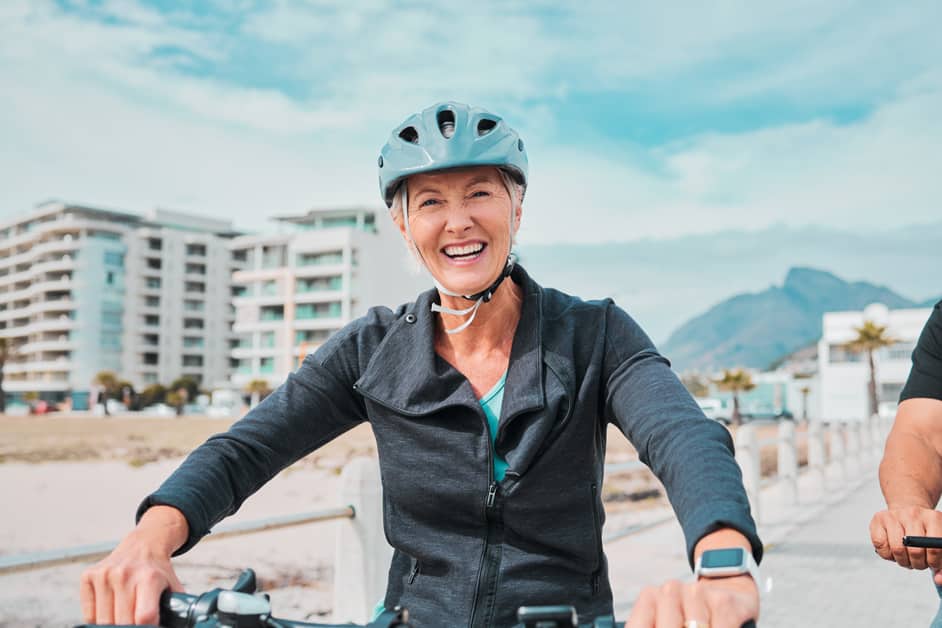Introduction
Cycling rocks! It’s a low-impact workout that’s kind to your knees. It tones the muscles in your legs while keeping your joints healthy. Plus, it helps maintain weight, increases cardiovascular endurance and strengthens bones. And it’s also great for building strength and agility!
So why not hop on a bike and enjoy all the benefits that come with cycling?
Benefits of Cycling
Cycling is great for burning calories without stressing the knee, hip, and lower body. A smooth, circular motion of pedaling uses big and small muscles all over the body – making you stronger, fitter, and healthier. Plus, there are many other benefits too!
Such as:
- Improved mental health – cycling can be calming and reduce stress, depression, and anxiety.
- It’s low-impact on weight bearing joints, so it’s safe for those with arthritis or joint issues.
- Cycling helps you lose weight and gives you energy.
- Finally, it keeps muscles flexible and prevents injury while improving posture.
Types of Cycling
Types of cycling are varied! Cycle in many ways. Mountain biking, cyclocross racing, bike touring, indoor cycling – so many choices. Get moving and your heart pumping. What type of cycling suits your goals? Let’s take a closer look and decide!
- Mountain biking
- Cyclocross racing
- Bike touring
- Indoor cycling
Road Cycling
Road cycling is a popular and versatile activity. Riders go along paved roads, urban streets, or back country roads. The terrain affects speed and difficulty. Competitors train for the courses they race on. Tourists like long stretches of road with few stops. Commuters want to get from A to B quickly.
There are many benefits to road cycling:
- Connecting with nature
- Building endurance and cardiovascular function
- Increasing flexibility
- Reducing stress levels
- Building muscle strength
Get the right equipment such as a helmet, clothing protection, and a suitable bike. Then you can start pedaling your way to better health!
Mountain Biking
Mountain biking is a type of cycling that involves outdoor, off-road terrain. It requires higher levels of skill and strength than road cycling. Mountain bikes have wider tires and flat handlebars for better control, plus suspension forks for shock absorption. The aim of mountain biking is to ride through obstacles like trees, rocks, and mud. Mountain bicycle racing is a popular sport too, where riders compete to complete courses within certain time limits.
Mountain bikes provide great low-impact cardio exercise due to the extra stability on bumpy terrain. It’s a good way to build leg strength without overworking your joints. When riding, focus on proper body position. Using your hips for shock absorption can protect your knees.
Stationary Cycling
Stationary cycling is an exercise form, done on special bikes. It helps with heart and muscle health, and increases aerobic performance and muscular endurance. The exercise can take place inside or outside.
Indoor stationary cycling usually uses an adjustable resistance knob to change the difficulty. Some machines have a screen interface, coaching guidance and heart rate tracking.
Outdoor stationary cycling involves riding an unmodified road bike, either at home or in a public park. The benefits are the same as indoor cycling, but more mental focus is needed. Safety equipment such as helmets, gloves and lights are also needed when training outside at night.
Knee Health and Cycling
Cycling is fab! It’s a low-impact cardio workout. It helps the muscles around your knee grow stronger. It also boosts range of motion, flexibility, and balance. Plus, it’s low-impact so it won’t cause injuries.
Let’s look at how it helps your knee health:
Low-Impact Exercise
Cycling is great for knee health! Low-impact activities cause less stress on joints, tendons, and ligaments. This reduces wear and tear. Cycling is also a great treatment for stiff or achy knees due to osteoarthritis (OA) and other conditions.
Cycling helps build strength in the muscles around the knee, including the hips, glutes, and thighs. This helps improve joint alignment, reducing pain and enhancing leg stability. Cycling is great for overall health and wellbeing!
Proper technique is important for cycling. Make sure your bike fits properly to avoid pain or discomfort. Pedals should be adjusted so the foot is at 3 o’clock when you reach out with your toes (right pedal at 1 o’clock). Handlebar and saddle heights should be level. Wear supportive shoes for cushioning and protection. Consult an orthopedic physician or physical therapist for individualized exercise plans designed for your needs.
Strengthening Muscles
Cycling has low-impact benefits, and is great for your knees! It helps build strength in your legs and the muscles around your knees. Strengthen your quadriceps, glutes, and hip flexors. To get extra protection, work on your smaller stabilizing muscles too.
Do bridges, leg extensions, and curls with weights or resistance bands several days a week. Keep your knees healthy!
Proper Form
Good form is key for low-impact cycling and minimal knee strain. Adjust your seat and handlebars to achieve good posture while gently pedaling. Sit upright or lean back with arms comfortably away from your body. Your feet should rest on the pedals in a comfortable position and you can reach forward to the handlebars without having to slump or overextend.
Check your posture every few minutes. This helps keep your body aligned and all parts get an equal workout. Keep a gentle but consistent grip on handlebar grips/hoods. Avoid bearing down hard when climbing hills and keep even pressure when going downhill.
Don’t overdo it when achieving proper form. This can add more strain on your knees than improper form! Take breaks for recovery. This reduces tension in tired muscles and keeps joints loose. Cycling regularly with proper form benefits cardiovascular fitness and knee health!
Cycling Gear
Cycling requires the right gear and apparel. To protect your knees and enjoy the ride, there are must-have items. Here’s what you need:
- Helmet: Don’t forget this! It will keep you safe in case of a fall. Some helmets even have built-in lights and Bluetooth.
- Gloves: Choose a pair that fits snugly while allowing freedom of movement.
- Clothing & Shoes: Look for performance fabrics that wick sweat. Shoes should be supportive and allow clearance when walking. Choose garments with mesh pockets for snacks and water.
- Accessories: Get glasses with polarized lenses for sun protection. Also, have tire pumps and repair kits. Saddle mini tool bags are great for convenience.
Safety Tips
Cycling is a fab cardio workout with low impact – perfect for people with knee injuries or joint problems. To stay safe and protect your knees, bear these tips in mind!
- Make sure you have the right bike fit.
- Pedal in a low gear to reduce strain on your knees.
- Pedal with a smooth, even motion.
- Warm up and stretch before and after each ride.
- Wear protective gear like knee pads.
- Take regular rest breaks.
Wear a Helmet
When cycling, wearing a helmet is the most essential safety measure. According to the CDC, it reduces head injury risk by up to 88%. Make sure your helmet fits well and is securely fastened. Snug but not too tight. Replace it every few years, as the material may degrade and its shock-absorbing abilities may lessen.
Check if your bike has light reflectors. This way, you are more visible in low-light or at night.
Use Lights
Cycling at dawn and dusk? Don’t forget to use your lights! To be visible to cyclists, pedestrians and motorists, secure a front light to your bicycle and place a rear near your body. The color of your lights depends on night conditions. If it’s pitch dark, a strong white light will make you visible from afar. For daylight, go for vibrant red for better visibility.
According to research from the University of Strathclyde, 85% of cyclists who wear fluorescent clothing during the day have fewer accidents. Wear reflectorized clothing and lighting equipment at night to be safe on your rides!
Wear Reflective Clothing
Increase your safety while cycling by making yourself visible! Wear a helmet, make sure it’s fastened and properly fitted. Reflective clothing is a must, like a reflector vest or bike jacket, so you stand out in low light or at night.
If you cycle in the dark, fit your bike with headlights and tail lights so drivers in all directions can see you.
Conclusion
To wrap up, cycling is a great way to get some cardio and look after your physical and mental health. It’s especially good for people with knee problems, as it puts less strain on the joints than other exercises like running or jogging. Plus, cycling has lots of other advantages. You can vary your workouts, do it indoors or outdoors and it’s cheaper than many other sports. All in all, if you have knee issues that stop you from doing high-impact activities, it’s worth giving cycling a go!
Frequently Asked Questions
Q: What is the benefit of cycling for knee health?
A: Cycling is a low-impact cardio exercise that is great for knee health because it strengthens the muscles that support the knee joint without putting too much strain on the joint itself. It also helps to improve flexibility and range of motion, which is beneficial for the overall health of your knees.
Q: Are there any tips for cycling that can help me protect my knees?
A: Yes, there are a few tips you can follow to help protect your knees while cycling. Make sure your bike is properly fitted to your body and your seat is at the correct height. Also, try to avoid sudden stops and turns while cycling, as these can put extra strain on the knee joint. Finally, pay attention to how your body is feeling and take breaks when needed.
Q: What type of bike is best for knee health?
A: Any type of bike can be beneficial for knee health, but a hybrid or mountain bike may be best since these bikes have suspensions that help absorb the impact of the ride and reduce stress on the knees. Additionally, electric bikes are another great option, as they can provide assistance when climbing hills and other challenging terrain.





